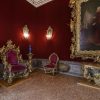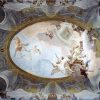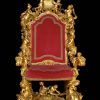The decoration of the wedding couple’s apartment ends with the ceiling of this last room, again frescoed by Giambattista Tiepolo with the collaboration of Girolamo Mengozzi Colonna. It shows Merit as a bearded old man crowned with laurels rising to the Temple of Immortal Glory accompanied by Nobility (the winged figure holding a spear) and Virtue (the richly-dressed figure to the right of the old man). Other allegorical figures and cherubs crown the scene. One of these, beneath the figure of Merit, is holding the Golden Book of the Venetian Nobility where the names of patrician families were registered, including that of the Rezzonico family from 1687 onward.
This room, lined in red velvet, takes its name from the gilded wooden throne decorated with cherubs, sea-nymphs and sea-horses. This was used by Pius VI on 10th March 1782, when he stayed in Chioggia as a guest of the Grassi family. It was however made considerably before that date, in the first decades of the 18th century, and it shows the quality and exuberance of Brustolon’s carving, updated to suit a less pompous, less showy taste. Less austere gilding were now preferred to the dark, glossy late 17th-century materials, and they helped to refine the ornamentation which was still quite massy.
The rich furniture of the room is in the same taste. This includes the imposing frame on the wall to the left of the entrance door with its rich allegorical decoration celebrating the moral virtues of the patrician Pietro Barbarigo, the subject of the portrait. Starting from the Babarigo coat-of-arms at the top and proceeding clockwise, we see in order: Patriotism, Charity, Constancy, Magnanimity, Prudence, Justice and Faith. The remaining part of the furniture includes an elaborate console, and four armchairs so finely carved that they were at one time attributed to the sculptor Antonio Corradini; this artist however actually never made any works in wood. This suite of furniture combines Baroque ornamental motifs, such as the full-relief figurative elements, with a new lighter, more graceful kind of workmanship (for example, elimination of linking elements on the armchair legs). This approach eventually led to the more slender shapes and smaller proportions which we saw in the furniture of the previous room.


